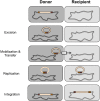Regulation of CTnDOT conjugative transfer is a complex and highly coordinated series of events
- PMID: 24169574
- PMCID: PMC3809561
- DOI: 10.1128/mBio.00569-13
Regulation of CTnDOT conjugative transfer is a complex and highly coordinated series of events
Abstract
CTnDOT is a 65-kb conjugative transposon that is found in Bacteroides spp., which are one of the more abundant members within the lower human gastrointestinal tract. CTnDOT encodes resistance to the antibiotics erythromycin and tetracycline (Tc). An interesting feature of CTnDOT is that exposure to low levels of Tc induces a cascade of events that ultimately results in CTnDOT conjugative transfer. However, Tc is apparently not a switch that activates transfer but rather a signal that appears to override a series of negative regulators that inhibit premature excision and transfer of CTnDOT. In this minireview, we summarize over 20 years of research that focused on elucidating the highly coordinated regulation of excision, mobilization, and transfer of CTnDOT.
Importance: Bacteroides spp. are abundant commensals in the human colon, but they are also considered opportunistic pathogens, as they can cause life-threatening infections if they should escape the colon. Bacteroides spp. are the most common cause of anaerobic infections and are rather difficult to treat due to the prevalence of antibiotic resistance within this genus. Today over 80% of Bacteroides are resistant to tetracycline (Tc), and a study looking at both clinical and community isolates demonstrated that this resistance was specifically due to the conjugative transposon CTnDOT.
Figures


Similar articles
-
Tetracycline-related transcriptional regulation of the CTnDOT mobilization region.J Bacteriol. 2013 Dec;195(24):5431-8. doi: 10.1128/JB.00691-13. Epub 2013 Sep 27. J Bacteriol. 2013. PMID: 24078614 Free PMC article.
-
Tetracycline-associated transcriptional regulation of transfer genes of the Bacteroides conjugative transposon CTnDOT.J Bacteriol. 2009 Oct;191(20):6374-82. doi: 10.1128/JB.00739-09. Epub 2009 Aug 21. J Bacteriol. 2009. PMID: 19700528 Free PMC article.
-
The Integration and Excision of CTnDOT.Microbiol Spectr. 2015 Apr;3(2):MDNA3-0020-2014. doi: 10.1128/microbiolspec.MDNA3-0020-2014. Microbiol Spectr. 2015. PMID: 26104696 Free PMC article. Review.
-
The role of Bacteroides conjugative transposons in the dissemination of antibiotic resistance genes.Cell Mol Life Sci. 2002 Dec;59(12):2044-54. doi: 10.1007/s000180200004. Cell Mol Life Sci. 2002. PMID: 12568330 Free PMC article.
-
Antimicrobial resistance in Bacteroides spp.: occurrence and dissemination.Future Microbiol. 2009 May;4(4):413-23. doi: 10.2217/fmb.09.12. Future Microbiol. 2009. PMID: 19416011 Review.
Cited by
-
The hidden life of integrative and conjugative elements.FEMS Microbiol Rev. 2017 Jul 1;41(4):512-537. doi: 10.1093/femsre/fux008. FEMS Microbiol Rev. 2017. PMID: 28369623 Free PMC article. Review.
-
The extended regulatory networks of SXT/R391 integrative and conjugative elements and IncA/C conjugative plasmids.Front Microbiol. 2015 Aug 20;6:837. doi: 10.3389/fmicb.2015.00837. eCollection 2015. Front Microbiol. 2015. PMID: 26347724 Free PMC article. Review.
-
A quantitative approach to measure and predict microbiome response to antibiotics.mSphere. 2024 Sep 25;9(9):e0048824. doi: 10.1128/msphere.00488-24. Epub 2024 Sep 4. mSphere. 2024. PMID: 39230261 Free PMC article.
-
Mobile genetic elements in Clostridium difficile and their role in genome function.Res Microbiol. 2015 May;166(4):361-7. doi: 10.1016/j.resmic.2014.12.005. Epub 2015 Jan 7. Res Microbiol. 2015. PMID: 25576774 Free PMC article. Review.
-
In Silico Identification of Three Types of Integrative and Conjugative Elements in Elizabethkingia anophelis Strains Isolated from around the World.mSphere. 2019 Apr 3;4(2):e00040-19. doi: 10.1128/mSphere.00040-19. mSphere. 2019. PMID: 30944210 Free PMC article.
References
Publication types
MeSH terms
Substances
LinkOut - more resources
Full Text Sources
Other Literature Sources
Miscellaneous

